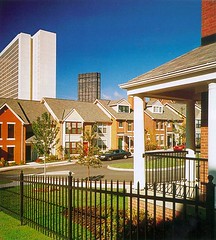Affordable housing without the stigma: it's all in the detail

Posted May 28, 2008 at 12:30AM
I know it may shock readers to learn this, but I am not a regular reader of the Financial Times. I do kind of like its flesh-colored visual tone, though, and my first-language reading options have been limited while in Germany and the Czech Republic.
All this is a rather indirect way of introducing the subject at hand (sorry, Ian), which is that the FT has run a very good story ("All in the detail: Thoughtfully designed affordable housing can help remedy social problems," by Mark Ellwood) on how good design can help make affordable housing fit into a neighborhood so that both its residents and neighbors regard it with more pride and care. Having grown up in an era when it seemed like any sort of subsidized housing was designed to be as dreary as possible, I love it that good people are putting thought into this subject and creating great projects.
 This is part of what the HOPE VI program, which I cited in an earlier post, is about, of course. It is also a subject dear to my heart, since I was born into postwar public housing in Hickory, North Carolina, where I lived with my parents until they could afford something a little better some years down the line.
This is part of what the HOPE VI program, which I cited in an earlier post, is about, of course. It is also a subject dear to my heart, since I was born into postwar public housing in Hickory, North Carolina, where I lived with my parents until they could afford something a little better some years down the line.
Ellwood's article in the FT cites a number of champions of the concept, including Brad Pitt, Habitat for Humanity, and especially Ray Gindroz, professor emeritus of architecture at Yale and new chair of CNU:
[Gindroz] started his firm during the civil rights movement and from the outset has focused on how social problems can be solved – or at least, eased – through architecture.
He believes any house that looks or feels like a low-cost afterthought will be treated that way by its residents. “Every neighbourhood in the world has a set of physical as well as social characteristics and our approach is to create dwellings which are consistent with their surroundings,” he explains.
One experience in particular helped Gindroz refine his design theories – a public housing do-over in Norfolk, Virginia. The city’s renovation budget had been approved and standard plans to replace windows and kitchens readied; then Ray was brought in to reimagine the project. “We met extensively with the residents and they identified the particular elements of a ‘regular neighbourhood’ – and they did call it that – which they didn’t have.”
For example, there were no chitchat-ready porches; the red brick everywhere was utilitarian and lacked finishing white trim; and without ornament of any kind, homes more resembled barracks than residences.
“They didn’t have fences to define the backyards and there was no way of protecting their front lawns from gangs that tramped over them. And the police chief told us the best security is a front garden with flowers in it: it’s a [psychological] signal to the drug gangs that this is not an easy place to do business,” Gindroz explains. “All that was needed was a little white fence at the corner of each garden.”
What’s more, when Gindroz and his team retro-fitted porches on to the Norfolk houses, they decided to use neo-classical columns made from wood instead of cheap industrial siding.
“It was to the absolute horror of the maintenance crews of the housing authority,” he chuckles. “But it turned out that they have been carefully maintained by the residents because they have become objects of pride, a touch that makes the area feel like ‘a regular neighbourhood’.”
Read the whole article here. You can also watch a short video of Ray talking about the importance of this issue, climate change, and other matters in which CNU plans to be engaged.
There are reasons that range beyond the environmental to support activities like these. This is about community, and building an inclusive society. But this is also environmental: We need cities to be strong, safe, and comfortable for all, in order to overcome the myriad environmental problems posed by unchecked sprawl. Affordable housing is a big part of the solution and must continue to be a big part of the smart growth agenda. We are quite literally all in this together. And I love it that thoughtful people like Ray Gindroz are on the job.